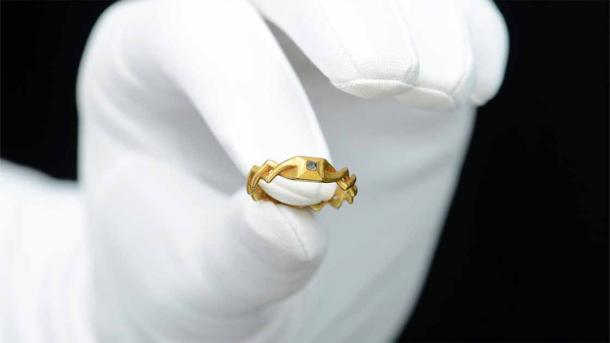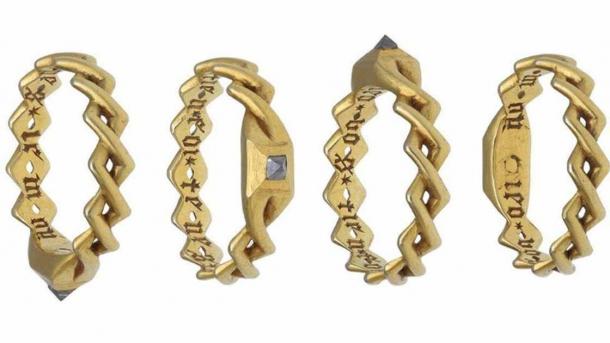
Metal Detected Medieval ‘Love Ring’ Might Fetch Over $40K
An English metal detectorist has unearthed a medieval “love ring” made of gold and diamonds. With its noble heritage known, this rare golden artifact has been valued at a show-stopping $40,000.
Englishman David Board had given up metal detecting around 40 years ago. This year, however, David retired and bought himself a new detector. Only 12 weeks later the treasure hunter was scanning a farmer’s field in Thorncombe, in the county of Dorset, when he unearthed a rare gold and diamond ring.
This unique piece of medieval jewelry has a noble pedigree and much to the detectorist’s shock it’s expected to sell for £30-40,000 at auction in London later this month.
- A Timeworn Scroll Reveals King Henry VII’s Interests in New World Colonization
- The Headless Vikings of Dorset

The medieval ‘love ring’ is valued higher due to its interesting pedigree. (Noonans)
What’s Not To Love
The 600-year-old gold and diamond ring was a gift from Sir Thomas Brook (c.1355-1418), a wealthy 14th-century landowner, to his wife, Lady Joan. In the “ History of Parliament” we learn that Sir Brook served 13 times as a Member of Parliament for Somerset between 1386 AD and 1413 AD, after he acquired “great wealth from his marriage to a wealthy widow” (Joan Hanham).
Formed by two angular entwined bands and weighing about 3g (0.1oz), Noonans auctioneers describe this late 14th century artifact as a “love ring.” A square rising pyramidal bezel is set with a pyramidal diamond crystal and the ring’s interior bears a black inscription written in medieval French reading: “ieo vos - tien - foi - tenes - le moy” which translates to ‘As I hold your faith, hold mine’”.

The medieval gold ring has an inscription in Medieval French. (Noonans)
A Debt Swiping Swoop
The detectorist, Mr Board, told the BBC that a farmer friend had given him permission to detect on his land. Research informed him that one of the fields was called “Bowling Green'' and he noticed it was quite flat. As a metal detectorist he knew that most treasures are recovered from places that people frequented most often like beaches, parks and sporting venues, so he swiped the field two times before discovering the ring on the third attempt.
The discoverer said the gold diamond ring is “a once in a lifetime find.” And it really is when we consider it has been valued at between 30,000 and 40,000 pound sterling, and that as of March 2020, according to Moneynerd, the average personal debt of people in the UK is £33,410. Therefore, Board has unearthed what equates to a life changing find for most Brits.
This is where all other news articles end their coverage of this story, but it’s where we get going, for all the pieces are in place for the historical detective to make some educated guesses as to what happened back in the 14th century leading up to the loss of the so-called love ring.
- 13th Century Magical Merlin Manuscript Shares Original Legend
- Kings Weston Roman Villa, Where a Murder Lay Hidden for 1500 Years
This Power-Couple Were Richer Than Most Of Us Can Conceive
Sir Thomas Brook was the son and heir of Thomas Brook (d.1367 AD) of Holditch and la Brooke-juxta-Ilchester and wife Constance Markensfeld (or Markensfield). Already personally super-rich, In 1388 AD Brook married Joan Hanham who was the ‘mega-rich’ heiress of Simon Hanham of Gloucestershire and the widow of Robert Cheddar, the rich British cloth merchant who was twice Mayor of Bristol.
According to the “ History of Parliament” - “Lady Brook’s wealth was proverbial and comprised 17 manors, five advowsons, and very extensive properties scattered throughout Devon, Dorset, Somerset and Gloucestershire, besides 17 messuages, 21 shops, four cellars, 160 tenements and an advowson, all in Bristol".
Then, when Cheddar died, she inherited “20 manors in Somerset and others elsewhere” and her son also signed over his massive estate to his mother Lady Joan and her husband, Sir Brook.
Trust Is the Underfelt Of Love
With all these dowries, lands and assets at stake the pair must have lived in treacherously difficult political and financial environments. The ring is inscribed with “As I hold your faith, hold mine.” While the auctioneers describe this as a “love ring” it’s really much, much more when we consider the couple's deeply-complex financial interactions. Sir Brook is telling Lady Brook that she can “trust” him, and he is appealing for the same in return.
However, perhaps escaping the business pressures of her estates, one day, Lady Brook went bowling on a flattened field in one of her many Dorset estates and made a grave mistake. Bowling enthusiasts already know where I am going with this, and so too will golfers, tennis players and hunters because they all know you cannot perform proficiently wearing jewelry in any of these sports and pastimes. Lady Brook most probably slipped off her gold diamond ring and set it down before she bowled.
Perhaps she was distracted because she won the game, but maybe a messenger arrived with important news and she forgot to put the ring back on. Either way, it remained largely undisturbed in that field for over 600 years until metal detectorist David Board came along and rediscovered it.
Top image: Lady Brook’s medieval gold ring, up for auction at Noonans Mayfair. Source: Noonans
By Ashley Cowie
References
J.S. Roskell, L. Clark, C. Rawcliffe., 1993. Brook, Sir Thomas (c.1355-1418), of Holditch in Thorncombe, Dorset and Weycroft in Axminster, Devon, published in The History of Parliament: the House of Commons 1386–1421, ed.















